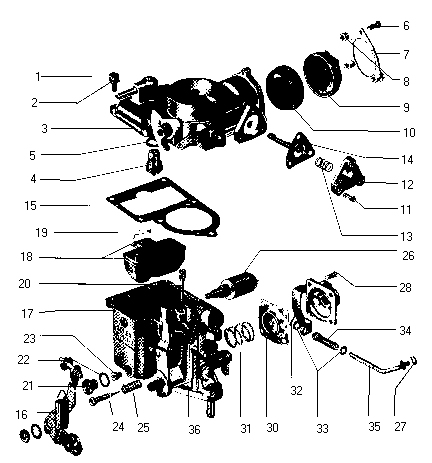Removal and Installation.
Disassembly.
Cleaning. Just about all auto part stores have some sort of carburetor cleaning solvent. Some come in the form of a spray can while others, the kind I use and recommend, come in a can (about the size of a paint can) which has a little basket inside the can in which to submerge your parts. A company called Gunk makes something called "Carburetor Dip", or at least they used to (it might be called something else now) which is what I use. It comes in a paint can with a small basket in which I can submerge my parts. Use compressed air to dry the parts. If you don't have access to an air compressor, most auto part stores and electronic part stores (ie: Radio Shack) sell compressed air in a can which also works fine. Aside from the automatic choke, clean all the parts. Use a clean cloth to wipe the choke. To clean the jets (and all the drillings in the carb body), I recommend using compressed air rather than a piece of wire or pins. You can run the risk of enlarging the holes. Reassembly. It's in the reverse order in which you took it apart. I recommend using a rebuild kit when it comes to reassembling your Solex. They don't cost all that much, about $10.00 (US) the last time I checked, and they include everything but the float and jets. It's a good investment.
Other Solex's are similar |
| 1 | Carburetor upper half screw | 13 | Diaphragm spring | 25 | Spring |
| 2 | Spring washer | 14 | Diaphragm | 26 | Pilot jet cutoff valve |
| 3 | Carburetor upper half | 15 | Gasket | 27 | Circlip |
| 4 | Float needle valve | 16 | Accelerator cable return spring | 28 | Fillister head screw |
| 5 | Needle valve washer | 17 | Carburetor lower half | 29 | Pump cover |
| 6 | Retaining ring screw | 18 | float and pin | 30 | Pump diaphragm |
| 7 | Retaining ring | 19 | Float pin bracket | 31 | Diaphragm spring |
| 8 | Retaining ring spacer | 20 | Air correction jet | 32 | Cotter pin |
| 9 | Automatic choke | 21 | Main jet plug | 33 | Washer |
| 10 | Plastic cap | 22 | Plug seal | 34 | Connecting rod spring |
| 11 | Fillister head screw | 23 | Main jet | 35 | Connecting rod |
| 12 | Diaphragm cover | 24 | Volume control screw | 36 | Accelerator pump injector tube |


